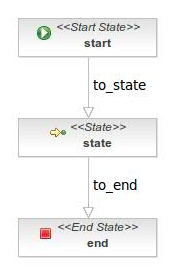Process modelling
We are going to describe the elements which define a jBPM process. A process is composed by:
- Nodes
- Transitions
To create a process definition in a graphical way, you can use jBPM Graphical Process Designer. This tool is packaged as a Eclipse plugin.
Nodes
The define the states of the process definition. They are connected by transitions. Both define the different path which can be followed in a running process definition. A running process definition is called process instance.
There are several types of nodes:
Start node
The start node defined the process entry point. Only one start node is permitted.
End node
End nodes define the end of the process execution. A process may have several end nodes. In this case the process finish when the process arrives to any of these end nodes.
Task node
A task node represents one or more tasks that are to be performed by humans.
Node node
You can define the behaviour using a Action element, which will be executed when the process arrives to the node.
State node
Decision node
There are 2 ways to model a decision. The distinction between the two is based on *who* is making the decision.
- When the decision is to be taken by the process, a decision node should be used.
- When the decision is taken by an external party, you should use multiple transitions leaving a state.
Fork node
A fork node splits one path of execution into multiple concurrent paths of execution.
Join node
The join node take all these concurrent executions before continue with the process execution.

